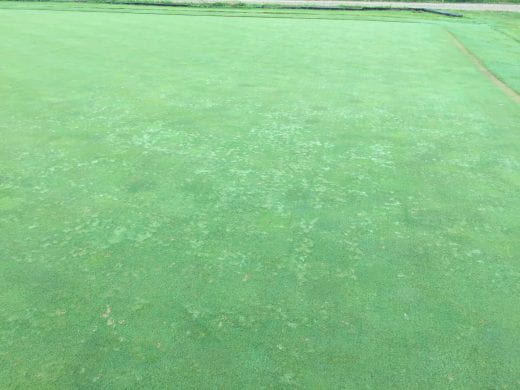(By Jared Hoyle, KSU Turfgrass Research and Extension)
At Rocky Ford Turfgrass Research Center in Manhattan, KS we have two bentgrass putting greens. On one of them we “try” to maintain as a common putting green with typical disease, weed and fertility programs. On the other one we don’t apply any fungicides at all to see what disease we can grow. On that same putting green we are growing a nice crop of silvery-thread moss as we aren’t doing anything to help suppress or control it.
When I came on board here at KSU in 2013, the KSU Turfgrass Faculty and graduate students were really diving into figuring out programs to help control or suppress silvery-thread moss in bentgrass putting greens. Quick to find out, controlling moss is not just an application but a program and part of that program is fertility.
I quickly went through some of the past research reports on the KSU Turfgrass Website (https://www.k-state.edu/turf/research/index.html) and came across a short report on the influence of nitrogen source and spray volume on the establishment of silvery-thread moss. Establishment! Establishment! Why are we studying the establishment? Well, knowing what helps establishment also tells you what is going to promote growth of silvery-thread moss.
As Drs. Raudenbush and Keeley explain in the research report, “the practice of spraying small quantities of soluble nitrogen at a relatively high frequency my promote silvery-thread moss growth because the moss lacks a vascular system of removing water and nutrients from the soil.” Apply small quantities of soluble nitrogen at relative high frequencies is a common practice for managing bentgrass putting greens, so we maybe making the problem worse.
To summarize the project that was conducted in the greenhouse, spraying soluble nitrogen increased moss cover compared with the untreated control and ammonium sulfate has the highest moss cover at all the ratings dates. Comparing ammonium sulfate to urea, ammonium sulfate caused more than a threefold increase in moss dry weight (At 7 weeks after the initial treatment the moss was harvested, dried and weighed.) and there was no difference between urea and the water only control.
There are many other factors to consider when looking at suppressing or controlling silvery-thread moss including but not limited to; watering, herbicide applications, topdressing and promoting healthy bentgrass. But remember fertility, as it does play a roll in silvery-thread moss management.
For the full report check out Page 12 of the 2014 Kansas State University Turfgrass Research Report – https://krex.k-state.edu/dspace/bitstream/handle/2097/20427/Turfgrass2014.pdf?sequence=1&isAllowed=y


